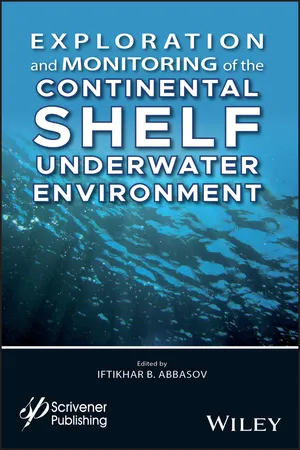
Exploration and Monitoring of the Continental Shelf Underwater Environment
- English
- ePUB (mobile friendly)
- Available on iOS & Android
Exploration and Monitoring of the Continental Shelf Underwater Environment
About This Book
Dedicated to the unique developments of hydroacoustical equipment to monitor the sea coastal shelf environment, this groundbreaking unique study presents a survey of modern methods and technical monitoring facilities, including the diagnostics of underwater engineering when monitoring offshore.
There is still so much about the oceans that scientists do not know, and exploring the continental shelves of the world is a huge part of finding out more about these underwater environments. Further to that, it is extremely important that, while scientists and engineers explore and monitor the continental shelf, no damage is done to these precious environments. That is the needle that this study intends to thread, giving scientists and engineers a better method and processes for exploring these underwater mysteries, while protecting the environment and wildlife thriving beneath.
Written by a proven scientist in this area, this book is dedicated to the unique developments of hydroacoustical equipment to monitor the coastal shelf. The results of the original experimental sonar studies with application of the parametric antenna are presented. The book presents a survey of the modern methods and technical monitoring facilities of the coastal aqueous environment. The basic characteristics of the parametric antennas are given considering propagation of the acoustic waves in the environments with dispersion and acoustical absorption. The author and his colleagues consider the questions of formation of the parametric antenna field in layered-heterogeneous media and the peculiarities of sounding of the interfaces and bottom sediments. Ecological monitoring methods of the basic parameters of quality and condition of the aqueous environment are analyzed. The peculiarities of diagnostics of the underwater engineering constructions when monitoring the offshore strips are described.
For both veteran engineers and students in the field alike, this breakthrough study is a must-have for any scientific library concerned with studying the oceans and especially the continental shelf.
Frequently asked questions
Information
Chapter 1
Monitoring of Aqueous Environment of the Continental Shelf: The Current State
Abstract
1.1 Introduction
World Ocean – main part of hydrospace, continuous, but not solid water shell of the Earth, surrounding continents and islands and distinct with similarity of salt composition. World Ocean covers almost 70.8% of the Earth’s surface (Gross, 1972) (Dobroliubov, 2014).Ocean – (Old Greek Ὠκεανός, by the name of the Old Greek god Ocean) – largest water body, comprising the part of the World Ocean, located among the continents, having system of water circulation and other specific features.Continental shelf, shelf – aligned part of underwater continent edge, adjoining to dry land and characterizing of the geological structure common with it, includes sea bottom and subsoil of submarine areas, as a rule, considered within the range of 200-mile economic zone.Marine natural environment – aggregate of components of the natural environment, natural and natural/man-made features, located within the range of continental shelf and water space over it.Aquatic area – water air surface within the range of the natural, artificial or conventional borders.Environment monitoring – integrated environment observations, including its components, natural ecological systems, over the processes occurring within them, phenomena, evaluation and prediction of change of the environmental state.
- common monitoring and diagnostics tasks;
- satellite data use for the remote diagnostics;
- seismic activity monitoring of sea bottom;
- fish stock monitoring;
- submarine technical facilities for the archeological research;
- underwater vehicles for geological exploration;
- monitoring of ecosystems with use of underwater vehicles;
- modern state of underwater monitoring vehicles;
- hydro acoustical systems of remote shelf diagnostics.
1.2 General Monitoring Tasks
- revelation and analysis of the specific anthropogenic sources and interaction factors on the natural environment;
- comprehensive analysis of the environment in the regions of possible impact;
- ecological monitoring of the natural facilities and processes, exposing to impact.
- Monitoring structure of the anthropogenic changes of the natural environment shall include the following basic blocks (Figure 1.1):
- observance of the sources and factors of impact;
- evaluation and prediction of the actual state of the natural environment.

1.3 Remote Monitoring with the Help of Satellites
- variations of hydro-optic characteristics, color and turbidity of water;
- changes of hydrodynamic parameters (flow fields, internal waves, turbulence, circulating flows), leading to deformations of the surface variation and changes of characteristics of the near surface ocean layer;
- temperature variations in the areas of the flow fields, upwelling, interaction of turbulence and the internal waves with water surface;
- fluctuations of p...
Table of contents
- Cover
- Title page
- Copyright page
- Dedication
- Abstract
- Preface
- Chapter 1: Monitoring of Aqueous Environment of the Continental Shelf: The Current State
- Chapter 2: Parametric Antennas in the Mediums with Hydrophysical Inhomogeneities: Theory and Experiment
- Chapter 3: Research of the Phase Characteristics of Parametrical Radiators for Measuring Purposes
- Chapter 4: Influence of Layer-Discrete Areas on the Formation of the Direction Acoustic Parametric Antenna at the Diagnostic of the Water Environment
- Chapter 5: Experimental Research of Penetration of the Acoustic Inhomogeneous Plane Waves from Water into Air
- Chapter 6: Study of Nonlinear Interaction of Acoustic Waves Driven by Parametric Radiating Antenna During Sounding of Bottom Sediments
- Chapter 7: The Underwater Ultrasonic Equipment with the Nonlinear Acoustics Effect’s Application
- Chapter 8: The Research of Waters Eutrophication of the Gulf of Taganrog of the Sea of Azov For Ecological Monitoring Purposes
- Chapter 9: The Application Features of Sonar Systems for Control of Underwater Engineering Structures and Monitoring Area
- Index
- End User License Agreement